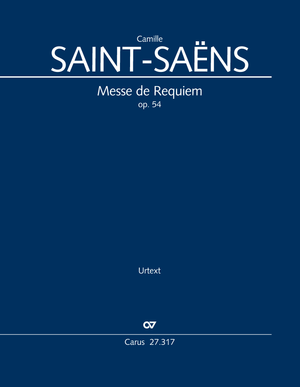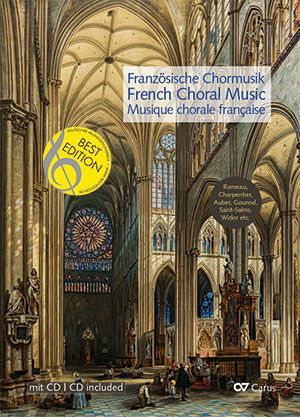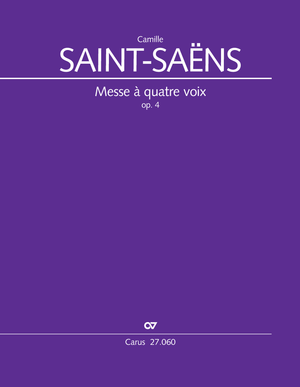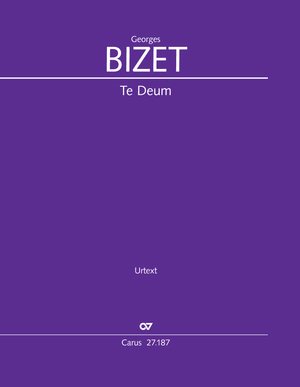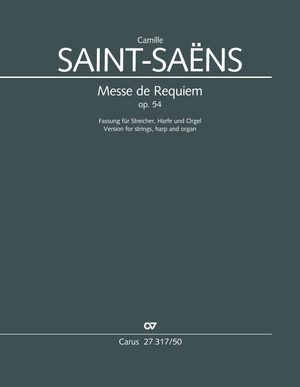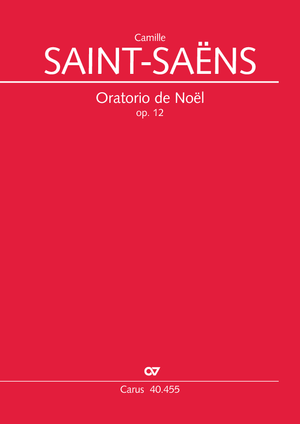Messe de Requiem
op. 54, 1878
During his most productive period as an opera composer, Camille Saint-Saëns also wrote sacred works, among which his Oratorio de Noël has enjoyed great worldwide popularity. The colorful and opulently orchestrated Messe de Requiem was composed in 1878 in Bern. The composer dedicated it to his patron, Albert Libon. We have published this edition both with its larger orchestral forces and to enable perfomances of the Requiem in slightly reduced scoring (without losing the special characteristics of the work), in a version with a smaller orchestra consisting of 11 winds, two harps, organ and string instruments. The full score reproduces the Urtext of the Requiem with its original scoring, whereas the performance material is presented and conceived so to enable it to be performed either in the original orchestration or the version with reduced forces.
Thanks to an arrangement by K. Rothaupt (Carus 27.317/50), it is possible to perform the work in smaller settings.
-
Composer
Camille Saint-Saëns
| 1835-1921Camille Saint-Saëns war ein wahres Multitalent. Er war Pianist, Dirigent, Organist, Musikwissenschaftler, Musikpädagoge und Komponist und erlangte vor allem durch den Karneval der Tiere und die Oper Samson et Dalila Bekanntheit.
Seine Sinfonie A-Dur komponierte er mit 15 und wurde bereits mit 16 an der Universität in Paris aufgenommen. Klavier, Orgel und Komposition studierte Saint-Saëns am Pariser Konservatorium und wurde 1852 Organist von Saint-Séverin in Paris. Im selben Jahr lernte er auch Franz Liszt kennen, welcher folgend einen Einfluss auf Saint-Saëns kompositorisches Schaffen ausübte. Ein Jahr später feierte er dann als Komponist sein musikalisches Debüt. Die Oper Samson et Dalila, die 1877 in Weimar uraufgeführt wurde, brachte ihm einen bis heute anhaltenden Erfolg an den Opernhäusern. Sein Weihnachtsoratorium Oratorio de Noël, das beim Carus-Verlag erhältlich ist, ist wohl das bekannteste seiner geistlichen Werke. Personal details
-
Editor
Fritz Näf
| 1943Fritz Näf studied solo singing at the Musikhochschule in Zurich and Freiburg/Breisgau and attended master courses given by Jenny Tourel and Ernst Haefliger. As a tenor he appeared in concerts in many parts of Europe, while continuing his studies as a choral and orchestral conductor. Between 1976 and 1986 he taught solo and ensemble singing at the Schola Cantorum Basiliensis, where he founded the Basle Madrigalists in 1978. Between 1986 and 2000 first he was director of the Winterthur Music School and Conservatory, and subsequently rector of the newly established Hochschule for Music and Theater in Zurich. Since December 2000 Fritz Näf has been full-time artistic director of the Swiss Chamber Choir (founded in 1997) and the Basle Madrigalists. He also continues to appear as a guest conductor with various choirs and orchestras. Personal details
Reviews
Ein interessantes Werk, das fernab jeglicher Äußerlichkeit unter die Haut gehen kann!
Gottesdienst und Kirchenmusik, Mai/Juni 2022
... Da ist es für die Praxis geradezu verführerisch, dass der Carus-Verlag den Schweizer Dirigenten Fritz Näf eine reduzierte Fassung hat erstellen lassen: So ist es auch in bescheideneren Verhältnissen zu realisieren, ...
Musica Sacra, 6/2019
... Die Überschaubarkeit und der größtenteils homophone Chorsatz sollten auch die Einstudierung des mittelschweren Werks zu einer gut lösbaren Aufgabe machen.
Ulrich Barthel, Chorzeit, 02/2021
Frequent questions about this work
Do I need special parts for the reduced orchestral version?
Do we really need 4 or 2 harps?
Do I really need two organs?
 There are no questions and answers available so far or you were unable to find an answer to your specific question about this work? Then click here and send your specific questions to our Customer Services!
There are no questions and answers available so far or you were unable to find an answer to your specific question about this work? Then click here and send your specific questions to our Customer Services!


